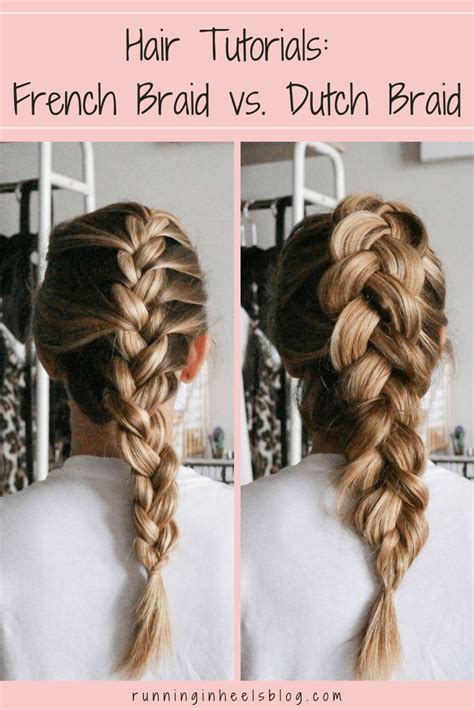Introduction
Braiding is an art form that has been passed down for generations. From intricate cornrows to elegant French twists, there is a braid style to suit every occasion. Two of the most popular braiding techniques are the Dutch braid and the French braid. Both styles create a beautiful and secure hold, but they have some key differences that set them apart.

Construction
Dutch Braid
- Starts by dividing the hair into three even sections.
- The left and right strands are crossed over the middle strand, creating an “under” braid.
- The next section of hair is taken from the left side and crossed over the middle strand, followed by the next section of hair from the right side.
- This process is repeated until all of the hair is braided.
French Braid
- Starts by taking a small section of hair from the top of the head and dividing it into three strands.
- The right strand is crossed over the middle strand, followed by the left strand over the middle strand.
- A small section of hair is taken from the side of the head and added to the right strand, which is then crossed over the middle strand.
- The same process is repeated on the left side, adding a small section of hair to the left strand before crossing it over the middle strand.
- This process is continued until all of the hair is braided.
Appearance
Dutch Braid
- Has a raised, three-dimensional look due to the “under” braiding technique.
- Creates a more voluminous and textured braid.
- Can be worn tight or loose, depending on the desired effect.
French Braid
- Has a flatter, more intricate appearance due to the “over” braiding technique.
- Creates a more polished and elegant braid.
- Is typically worn tight and close to the head.
Complexity
Dutch Braid
- Requires a little more skill and practice to master than the French braid.
- Can be challenging to braid on your own, especially if your hair is long or thick.
- May be more suitable for experienced braiders.
French Braid
- Is relatively easy to learn, making it a good choice for beginners.
- Can be braided on your own with relatively little effort.
- Is a versatile style that can be adapted for various hair types and lengths.
Versatility
Dutch Braid
- Can be worn as a standalone hairstyle or incorporated into more elaborate updos.
- Looks great on all hair types, including thick, wavy, and curly hair.
- Can be customized with ribbons, hair extensions, or other accessories.
French Braid
- Is a classic and timeless hairstyle that complements both casual and formal attire.
- Is often used as the base for more complex braided styles, such as the fishtail braid and the crown braid.
- Looks best on straight or slightly wavy hair, as it can be difficult to create a tight braid on curly or frizzy hair.
Time Required
Dutch Braid
- Typically takes longer to create than a French braid due to the more complex braiding technique.
- May take 15-30 minutes to complete, depending on the length and thickness of your hair.
French Braid
- Can be created in 5-15 minutes, making it a convenient hairstyle for everyday wear.
- Is a quick and easy way to style your hair when you’re short on time.
Which Braid is Right for You?
The best braid for you depends on your individual preferences and hair type. If you’re looking for a voluminous and textured braid that will make a statement, the Dutch braid is a great option. If you prefer a more polished and elegant braid that is easy to create and wear, the French braid is a classic choice.
Tips and Tricks
- Use a brush or comb to smooth out your hair before braiding to prevent tangles.
- Section your hair into even strands to ensure a balanced and secure braid.
- Hold the strands firmly and pull them tightly to create a secure and long-lasting braid.
- Use hairspray or a light mousse to keep your braid in place and prevent flyaways.
- Experiment with different braiding patterns and accessories to create unique and personalized styles.
Common Mistakes to Avoid
- Braiding too tightly, which can cause pain and damage to your hair.
- Not securing the end of the braid with a hair elastic or bobby pins, which can cause it to unravel.
- Trying to braid wet hair, which can be slippery and difficult to work with.
- Brushing your braid too much, which can cause it to lose its shape and volume.
- Sleeping with a braid in your hair, which can cause matting and tangles.
Conclusion
Whether you choose a Dutch braid or a French braid, you’ll have a beautiful and versatile hairstyle that will turn heads. With a little practice, you can master both techniques and create stunning braids that will enhance any look.
Additional Information
- According to a survey by the National Hairdressers Association, 75% of women have tried a Dutch braid at least once.
- The average time to create a French braid is 8 minutes, making it a quick and convenient hairstyle for busy individuals.
- Braiding has been shown to have therapeutic benefits, such as reducing stress and promoting relaxation.
